UNITED STATES
SECURITIES AND EXCHANGE COMMISSION
Washington, D.C. 20549
FORM N-CSR
CERTIFIED SHAREHOLDER REPORT OF REGISTERED
MANAGEMENT INVESTMENT COMPANIES
Investment Company Act File Number: 811-7059
| T. Rowe Price Blue Chip Growth Fund, Inc. |
| (Exact name of registrant as specified in charter) |
| 100 East Pratt Street, Baltimore, MD 21202 |
| (Address of principal executive offices) |
| David Oestreicher |
| 100 East Pratt Street, Baltimore, MD 21202 |
| (Name and address of agent for service) |
Registrant’s telephone number, including area code: (410) 345-2000
Date of fiscal year end: December 31
Date of reporting period: December 31, 2011
Item 1. Report to Shareholders
 |
| Blue Chip Growth Fund | December 31, 2011 |
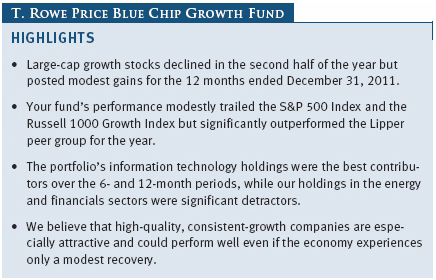
The views and opinions in this report were current as of December 31, 2011. They are not guarantees of performance or investment results and should not be taken as investment advice. Investment decisions reflect a variety of factors, and the managers reserve the right to change their views about individual stocks, sectors, and the markets at any time. As a result, the views expressed should not be relied upon as a forecast of the fund’s future investment intent. The report is certified under the Sarbanes-Oxley Act, which requires mutual funds and other public companies to affirm that, to the best of their knowledge, the information in their financial reports is fairly and accurately stated in all material respects.
REPORTS ON THE WEB
Sign up for our E-mail Program, and you can begin to receive updated fund reports and prospectuses online rather than through the mail. Log in to your account at troweprice.com for more information.
Manager’s Letter
Fellow Shareholders
Global stock markets declined in the second half of 2011, capping a year of volatile and inconsistent performance. U.S. equities generally outperformed international markets and posted gains for the full year. The primary challenges facing investors continue to be slow job growth and large structural deficits in many developed economies. Sovereign debt issues in Europe, the resultant slowdown in many European economies, and evidence that China’s economy may be slowing represent additional risks. Investors were also disappointed that a bipartisan solution to the U.S. structural deficit has not emerged.
However, some progress was made late in the year on the European debt crisis, and, perhaps more importantly, it appears that we are seeing signs of stronger U.S. economic growth. While the presidential election and other uncertainties will probably prolong market volatility, we maintain our view that stocks could perform reasonably well. If progress is made on the budget deficit and other policy issues, the combination of reasonable valuations and improving profit growth could drive solid gains in select stocks.
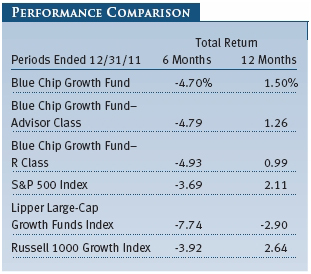
The Blue Chip Growth Fund lagged the S&P 500 Index and the Russell 1000 Growth Index by about one percentage point for the past 6- and 12-month periods. However, the fund outperformed its Lipper peer group index of similarly managed funds by approximately three percentage points in both periods. (Results for the Advisor and R Class shares varied slightly, reflecting their different fee structures.)
As shown in the Growth of $10,000 chart on page 13, the fund has outperformed the benchmark S&P 500 Index and its Lipper peer group over the past 10 years. Lipper ranked the fund in the top quintile of its large-cap growth funds universe for the 1- and 10-year periods ended December 31, 2011. (Based on cumulative total return, Lipper ranked the Blue Chip Growth Fund 136 of 758, 207 of 571, and 66 of 364 funds in the large-cap growth funds universe for the 1-, 5-, and 10-year periods ended December 31, 2011, respectively. Results may vary for other periods. Past performance cannot guarantee future results.)
MARKET ENVIRONMENT
It bears repeating that budget deficits at all levels of government in the U.S., particularly at the federal level, have justifiably concerned investors. If interest rates were to increase significantly, debt payments would become quite burdensome and could damage U.S. creditworthiness and economic growth. Unfortunately, with the passage of time, the probability of entering a period of rising rates increases. While significant tax increases appear to be ill advised at this time, the combination of larger spending cuts with tax simplification—including eliminating some tax loopholes, which would generate increased tax revenues—could be positive for investor confidence and, ultimately, economic growth. Regardless of actions on tax policy, major spending reductions will be required, and progress in this area has not been reassuring to date.
The budget crisis in several European economies has caused a significant devaluation in the euro and raised questions about the effective servicing of sovereign debt by several European countries. Certain European economies (particularly Germany) are fiscally sound, and austerity measures in several other economies and enhanced lending facilities stand a reasonable chance of fostering greater stability in Europe and the euro over time. Nevertheless, successful implementation of these remedies is far from assured and will probably restrain growth for some time.
There are other factors dampening global economic growth. China’s economy may slow more than anticipated, particularly if efforts to control inflation continue to cause property markets to weaken. Unrest in several Middle Eastern countries and Iran’s military operations in the Strait of Hormuz are contributing to higher oil prices and economic instability. While deficit reduction and other policy measures are needed to help stabilize the dollar and reduce the risk of inflation, there is no assurance that they will bolster job growth in the near term.
While recognizing the many challenges facing investors, there are several powerful positives and solid potential rewards in many stocks. Policy actions already taken (for example, the payroll tax cut extension) and other proposals could promote growth and lead to improvement in the deficit. Solid revenue growth, improved efficiency and margins, and ultimately robust corporate earnings are occurring despite high levels of unemployment and subdued capital spending. As overall demand improves, corporate earnings could be vibrant. Many companies have free cash flow yields approaching 10%, which is attractive relative to 10-year Treasury notes, which yield approximately 2%. While some stocks have appreciated, others remain reasonably valued and reflect the solid opportunity we believe exists in this market.
PORTFOLIO REVIEW
Despite lackluster market performance, many of our holdings in the information technology, consumer discretionary, and industrials and business services sectors performed well as investors slowly grew more confident that the global economy was improving. However, the overall performance of these sectors suffered when European sovereign debt concerns and the slowing of China’s economy became more visible. We think this pattern of inconsistent stock price behavior could continue for some time until these concerns are resolved to a greater degree. However, in general, we were pleased with the earnings results for many of our substantial contributors given the challenges posed by the economic environment.
In technology, Apple was our largest contributor over the past six months. The tragic death of Steve Jobs must be acknowledged as a significant loss for the company and for the world as well. Concerns regarding iPad sales also caused the stock to stumble a few times. However, in our view, the company continues to execute its strategy well, and the new iPhone 4S is selling at a fast pace. Apple’s IOS5 operating system and Siri artificial intelligence software provide significant improvements in accessing shared computing resources—i.e., the cloud—and overall functionality. Google was our second-largest contributor over the past six months. In our last report, we outlined some concerns weighing on the company’s stock, including the transition to a new CEO and fears regarding undisciplined spending. Its purchase of Motorola Mobility—primarily to get valuable patents supporting Google’s Android franchise—continues to concern investors and weighed on its shares. However, we believe that Larry Page has improved the company’s focus and efficiency and is doing an outstanding job as CEO. We are particularly impressed with the company’s Google+ initiative in social networking, as well as its continued efforts in mobile, video, and display and in its Chrome search engine and software products. MasterCard and Visa were also significant performance contributors. After stock weakness following passage of the Durbin legislation to regulate the level of debit card transaction fees, the pair rallied sharply. Both credit card companies are generating consistent earnings and free cash flow growth driven by their strong global franchises. (Please refer to the fund’s portfolio of investments for a complete list of holdings and the amount each represents in the portfolio.)
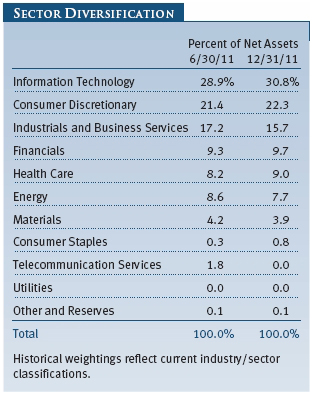
In consumer discretionary, our large position in Starbucks performed well as strong same-store sales and efficiency improvements drove solid profit growth. The company appears to be successfully expanding a number of new product lines sold in grocery stores, such as K-cups (single-serve roasted coffee used in specialized home brewers). McDonald’s also generated strong earnings growth and stock performance driven by improving same-store sales. Its consistent stock performance and impressive fundamental underpinnings differentiated the company from other major consumer discretionary and staples companies. Chipotle Mexican Grill was another solid contributor as its same-store sales and new store openings continued at a robust pace. O’Reilly Automotive, an auto parts retailer, has been one of the steadiest performers in the portfolio for the past several years. Its sales topped expectations in the last year, which contributed to strong share price gains. Longtime holding Nike methodically used its dominant position in rapidly growing Asian markets and various product areas to drive accelerating growth and strong stock performance. Ralph Lauren produced solid gains despite some concern that the company may not be able to sustain the growth rate it has posted in the past few years. The company has many desirable brands and solid positioning in growing global markets. Discovery Communications also produced strong results despite a relatively slow start for the new Oprah Winfrey Network. Its other cable networks, such as the Discovery Channel, the Military Channel, and Animal Planet, continue to perform well.
Within the industrials and business services area, our significant holdings in Fastenal and W.W. Grainger generated substantial gains. Both are leading industrial parts distributors. While their strategies differ slightly, they each have quality management teams and a long record of superior profitability. Our large position in longtime holding Union Pacific was a major contributor. We increased our railroad industry exposure with the purchase of new portfolio holding Kansas City Southern. It has a growing presence in serving Mexican markets and ports, and demand for the firm’s services is quite brisk. Our holdings in aerospace produced solid results. Precision Castparts, a leading manufacturer of forged and cast components used in aerospace and other applications, performed well. Its seamless extruded pipe is a major product line that should continue to generate strong profit growth. We also became more comfortable with the fundamentals at Boeing over the past year, and our large additions produced strong gains.
We had several notable contributors in other sectors. American Tower, the largest owner of mobile phone towers worldwide, converted to a real estate investment trust and generated solid gains. In health care, biotech leaders Celgene, which develops and manufactures drugs to treat various types of cancer, including multiple myeloma, and Alexion Pharmaceuticals, which produces drugs for the treatment of various kidney ailments, were standout contributors in the past six months. Similarly, Biogen Idec performed well. It has leadership positions in several areas including multiple sclerosis (MS). Its new oral agent BG-12 should be a major improvement in the treatment of MS. Alexion and Biogen were portfolio additions in the first half of 2011, while we have owned Celgene for many years. Allergan, a leading maker of ophthalmology products and aesthetics solutions (such as Botox) boosted performance. The use of Botox in more clinical applications, such as treatment of migraine headaches, is starting to generate significant sales.
The second half of 2011 was volatile, and we had several significant detractors, including Amazon.com. The online retailer had been a significant portfolio contributor for several years. In our view, Amazon continues to execute its strategy well, despite investor concerns about the Kindle Fire not being competitive with the more costly Apple iPad. We think the product, the level of innovation, and the customer service at Amazon are outstanding. However, the company’s aggressive investments, resultant margin pressures, and the earlier runup in the stock price led us to sell a portion of our position. At this point, we feel as though many of the concerns are reflected in the current stock price. This high-quality company continues to generate outstanding revenue growth (and strong customer retention), which should lead to improving profits. We continue to be circumspect regarding the appropriate position size but believe the company and its stock can perform well over time.
Franklin Resources was our second-largest detractor in the last six months. It suffered as investors fretted that its outstanding positioning and performance in the global fixed income investments area would not continue. In fact, the unsettled conditions in many foreign bond markets related to the European sovereign debt crisis did result in significant losses in some of Franklin’s bond funds. It is also true that at some point interest rates will rise, and bonds will not be the highly favored asset class they have been for over a decade. However, Franklin stock has a modest valuation, in our view. The company also has well-managed and growing products outside the fixed income area. While we have moderated our position somewhat, we think the company remains an appropriate and attractive investment.
Several energy holdings suffered as the fear of a double-dip recession and concerns regarding growth in China came to the forefront. Schlumberger, a leading oil services company and longtime holding, has been volatile. However, we recently met with the company’s new CEO, and we were reassured about the company’s prospects and his capabilities. Peabody Energy corrected sharply in the past six months. It generates an important portion of its income from metallurgical coal produced in Australia for steel production in China and other Asian markets. We were concerned about the possibility of a sharp slowing in these activities and sold a large portion of our holdings above the stock’s current price. However, this high-quality company also has profitable thermal coal operations that serve electricity-generating plants that provide steady demand. We think the company’s stock is attractively valued at current prices.
Baidu has been a volatile stock as the Chinese market corrected severely in 2011. Baidu is China’s dominant Internet search provider—with market share exceeding 80%—and has a growing presence in advertising services, e-commerce, and other related areas. Even though Baidu outperformed most other Chinese Internet companies in the sell-off, its stock is now at a value that our analyst believes is compelling. We recently met with the company’s management, and we came away believing Baidu can continue to generate strong revenue and profit growth, which should drive solid stock performance over time.
STRATEGY
Our largest purchases in the past six months were additions to existing positions in Priceline.com, Monsanto, Boeing, Biogen, Ralph Lauren, Express Scripts, Broadcom, Las Vegas Sands, and Cameron International. While we tend to focus on long-term performance, we certainly appreciate when our decisions lead to more immediate gains. Purchases of Monsanto, Boeing, and Biogen have appreciated in recent months, supported by solid fundamentals. Yum! Brands was the only new position among our top 10 purchases, and it has appreciated nicely since its inclusion in the portfolio. The company operates several major restaurant chains, including Pizza Hut, Taco Bell, and KFC, and has a large and growing presence in China and other international markets. We like the cash-and-carry aspect of restaurants and related concepts, and your fund has generated solid gains from these types of companies, including McDonald’s and Starbucks. We think Yum! is well managed and will garner a premium valuation as investors begin to better appreciate its growing overseas presence.
Our largest sales included the elimination of Corning. The company missed revenue and profit expectations several times as demand and pricing for liquid crystal display glass panels used in televisions and other applications deteriorated. While Corning is well run and management took actions that were shareholder oriented, including significant share repurchases, the specialty glass business has suffered pricing, revenue, and profit shortfalls that we fear could persist. While we made significant sales in several other stocks, two of our major sales were driven by disappointing operating fundamentals. Potash Corporation of Saskatchewan experienced a fall-off in demand for its key fertilizer product, which resulted in downward revisions to earnings estimates. Emerson Electric struggled to resolve issues in its network power division, and we elected to reallocate some of the position to other industrial companies that in our view are more attractive.
OUTLOOK
Lackluster economic growth and job creation in the U.S. and several major developed countries remain key challenges. The U.S. and other developed economies also face significant deficits that could imperil prospects for growth or even stability, particularly if interest rates rise significantly. In our last report, we noted that if policymakers deal with the situation in a decisive way, it could represent an important and timely trigger for sustained growth. Unfortunately, bipartisan solutions to reduce spending and address the large U.S. deficit have not been enacted. European authorities could be gaining traction in solving the sovereign debt problems that have plagued Greece and several other countries. China, India, and Brazil may be entering a period where early actions to combat inflation could yield good results. However, we acknowledge that these policymaking situations are complex, risky, and unlikely to develop in an optimal manner.
Other complicating factors may weigh on markets for some time. Unrest in the Middle East and the impact it could have on oil prices and general stability must be carefully monitored. Major spending cuts and other policy actions could dampen rather than enhance growth in the short run. Confidence among business managers and investors has improved (as has job growth) but may build slowly. Employment statistics underestimate the number of unemployed because many discouraged jobseekers have given up looking for work. Additionally, dollar instability and potentially sharp increases in inflation and interest rates constitute significant threats. For these reasons and others, we regard the current environment as having more complexity and risk than is typical.
On balance, we remain positive on the prospects for stocks over the long term. While the challenges we have enumerated will certainly require time to resolve and test the patience of policymakers and investors, corporate earnings at select companies could continue to impress, interest rates and inflation should remain at acceptable levels, and the valuations of many high-quality companies are quite reasonable.
Despite the uncertainty surrounding how effective fiscal and monetary actions will be in healing the economy, there are several things working in our favor:
1. Stocks historically have performed quite well following a lackluster 10-year period of performance. Essentially, we have experienced two major bear markets in the past 10 years.
2. The valuations of stocks are attractive, especially in relation to the very low level of interest rates. The spread between the earnings yield on stocks and the 10-year Treasury rate is very attractive in any historical context. The free cash flow yield of many companies exceeds 10% and implies attractive valuation, especially in the context of 10-year Treasury note yields of approximately 2%.
3. We believe that the high-quality, consistent-growth companies we seek to purchase are especially attractive and could conceivably perform well even if the economy only experiences a modest recovery. Stringent expense management could also support rapid earnings growth if revenues begin to accelerate.
4. Many large-cap growth companies have solid balance sheets with record amounts of cash and strong capitalization. This should allow them to manage through challenges and opportunistically invest in new products or businesses as change creates dislocation.
5. Many of our holdings generate significant free cash flow. Shareholder-oriented management can use this cash to pay dividends, repurchase shares, or make value-added acquisitions.
We continue to strive to enhance returns in a difficult environment by investing in quality companies with durable, sustainable earnings and cash flow growth. We appreciate your continued confidence in this endeavor.
Respectfully submitted,

Larry J. Puglia
President and chairman of the Investment Advisory Committee
January 13, 2012
The committee chairman has day-to-day responsibility for managing the portfolio and works with committee members in developing and executing the fund’s investment program.
RISKS OF STOCK INVESTING
The fund’s share price can fall because of weakness in the stock markets, a particular industry, or specific holdings. Stock markets can decline for many reasons, including adverse political or economic developments, changes in investor psychology, or heavy institutional selling. The prospects for an industry or company may deteriorate because of a variety of factors, including disappointing earnings or changes in the competitive environment. In addition, the investment manager’s assessment of companies held in a fund may prove incorrect, resulting in losses or poor performance even in rising markets. Growth stocks can be volatile because these companies usually invest a high portion of earnings in their businesses, and earnings disappointments often lead to sharply falling prices. The value approach carries the risk that a security’s intrinsic value may not be recognized for a long time or that the stock may actually be appropriately priced.
GLOSSARY
Free cash flow: The excess cash a company is generating from its operations that can be taken out of the business for the benefit of shareholders, such as dividends, share repurchases, investments, and acquisitions.
Lipper indexes: Fund benchmarks that consist of a small number (10 to 30) of the largest mutual funds in a particular category as tracked by Lipper Inc.
Price/book ratio: A valuation measure that compares a stock’s market price to its book value, i.e., the company’s net worth divided by the number of outstanding shares.
Price/earnings (P/E) ratio: A valuation measure calculated by dividing the price of a stock by its reported or projected earnings per share. This ratio is a measure of how much investors are willing to pay for the company’s earnings.
Russell 1000 Growth Index: An index that tracks the performance of large-cap stocks with higher price-to-book ratios and higher forecasted growth values.
S&P 500 Index: An unmanaged index that tracks the stocks of 500 primarily large-cap U.S. companies.
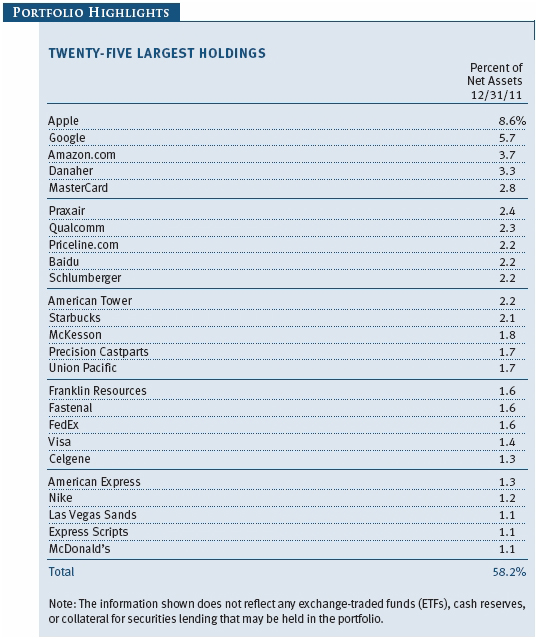
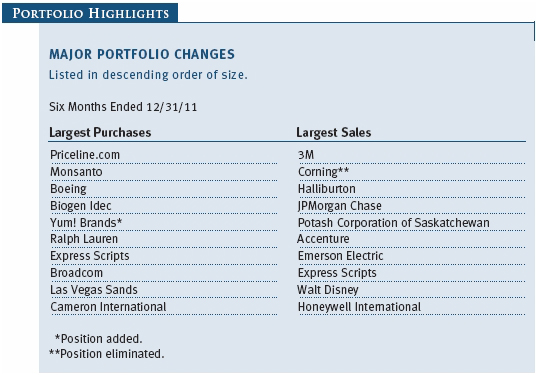
| Growth of $10,000 |
This chart shows the value of a hypothetical $10,000 investment in the fund over the past 10 fiscal year periods or since inception (for funds lacking 10-year records). The result is compared with benchmarks, which may include a broad-based market index and a peer group average or index. Market indexes do not include expenses, which are deducted from fund returns as well as mutual fund averages and indexes.
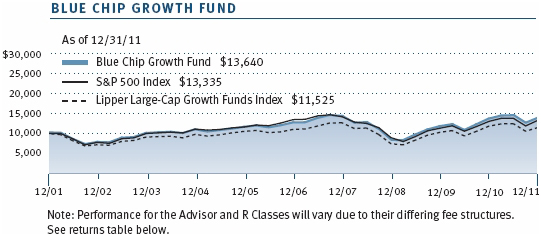
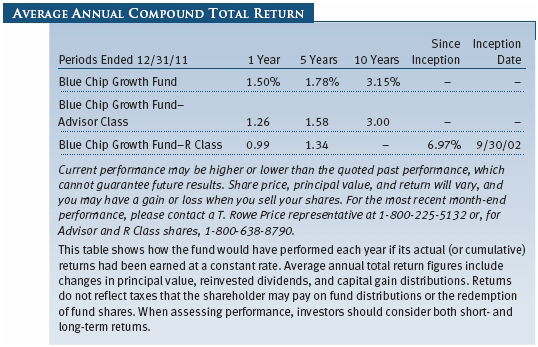

| Fund Expense Example |
As a mutual fund shareholder, you may incur two types of costs: (1) transaction costs, such as redemption fees or sales loads, and (2) ongoing costs, including management fees, distribution and service (12b-1) fees, and other fund expenses. The following example is intended to help you understand your ongoing costs (in dollars) of investing in the fund and to compare these costs with the ongoing costs of investing in other mutual funds. The example is based on an investment of $1,000 invested at the beginning of the most recent six-month period and held for the entire period.
Please note that the fund has three share classes: The original share class (“Investor Class”) charges no distribution and service (12b-1) fee, Advisor Class shares are offered only through unaffiliated brokers and other financial intermediaries and charge a 0.25% 12b-1 fee, and R Class shares are available to retirement plans serviced by intermediaries and charge a 0.50% 12b-1 fee. Each share class is presented separately in the table.
Actual Expenses
The first line of the following table (“Actual”) provides information about actual account values and expenses based on the fund’s actual returns. You may use the information on this line, together with your account balance, to estimate the expenses that you paid over the period. Simply divide your account value by $1,000 (for example, an $8,600 account value divided by $1,000 = 8.6), then multiply the result by the number on the first line under the heading “Expenses Paid During Period” to estimate the expenses you paid on your account during this period.
Hypothetical Example for Comparison Purposes
The information on the second line of the table (“Hypothetical”) is based on hypothetical account values and expenses derived from the fund’s actual expense ratio and an assumed 5% per year rate of return before expenses (not the fund’s actual return). You may compare the ongoing costs of investing in the fund with other funds by contrasting this 5% hypothetical example and the 5% hypothetical examples that appear in the shareholder reports of the other funds. The hypothetical account values and expenses may not be used to estimate the actual ending account balance or expenses you paid for the period.
Note: T. Rowe Price charges an annual account service fee of $20, generally for accounts with less than $10,000 ($1,000 for UGMA/UTMA). The fee is waived for any investor whose T. Rowe Price mutual fund accounts total $50,000 or more; accounts employing automatic investing; accounts electing to receive electronic delivery of account statements, transaction confirmations, prospectuses, and shareholder reports; accounts of an investor who is a T. Rowe Price Preferred Services, Personal Services, or Enhanced Personal Services client (enrollment in these programs generally requires T. Rowe Price assets of at least $100,000); and IRAs and other retirement plan accounts that utilize a prototype plan sponsored by T. Rowe Price (although a separate custodial or administrative fee may apply to such accounts). This fee is not included in the accompanying table. If you are subject to the fee, keep it in mind when you are estimating the ongoing expenses of investing in the fund and when comparing the expenses of this fund with other funds.
You should also be aware that the expenses shown in the table highlight only your ongoing costs and do not reflect any transaction costs, such as redemption fees or sales loads. Therefore, the second line of the table is useful in comparing ongoing costs only and will not help you determine the relative total costs of owning different funds. To the extent a fund charges transaction costs, however, the total cost of owning that fund is higher.
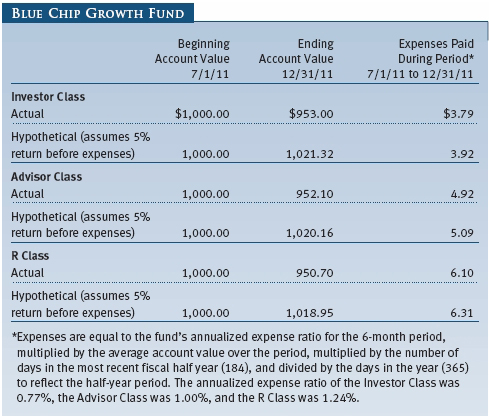
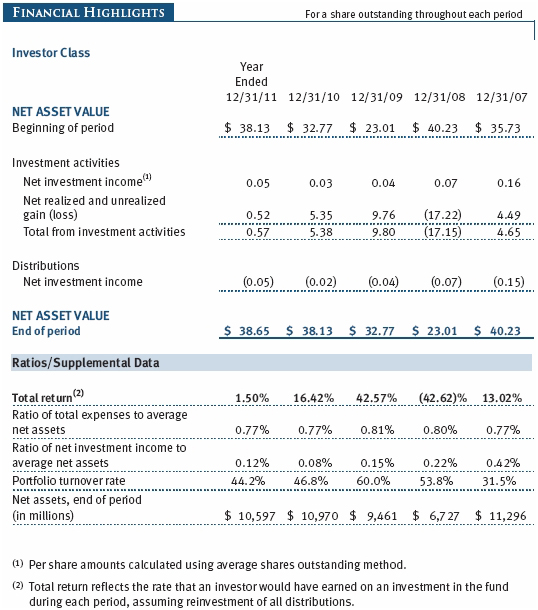
The accompanying notes are an integral part of these financial statements.
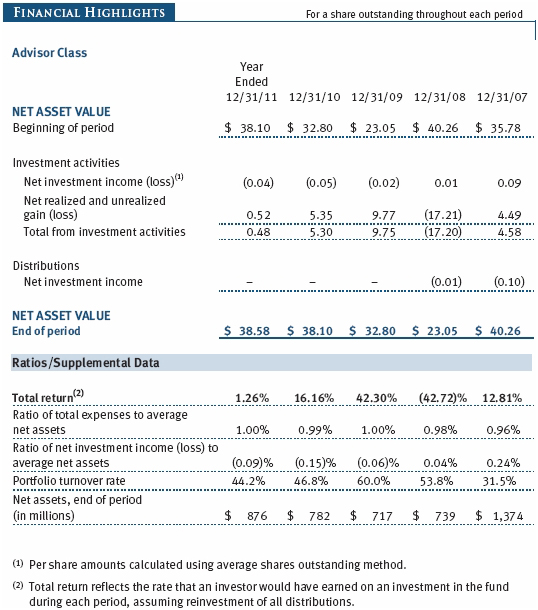
The accompanying notes are an integral part of these financial statements.
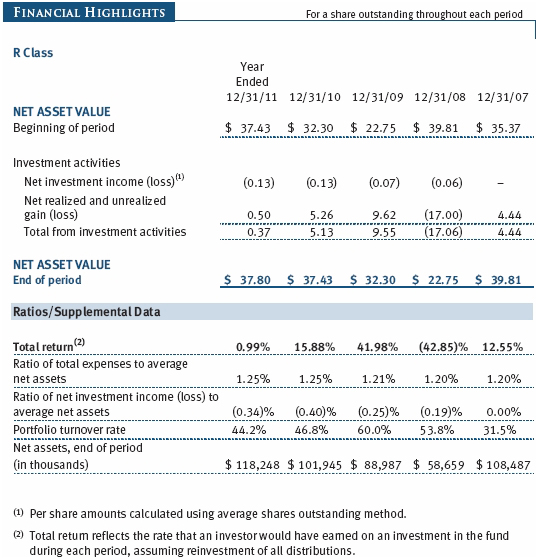
The accompanying notes are an integral part of these financial statements.
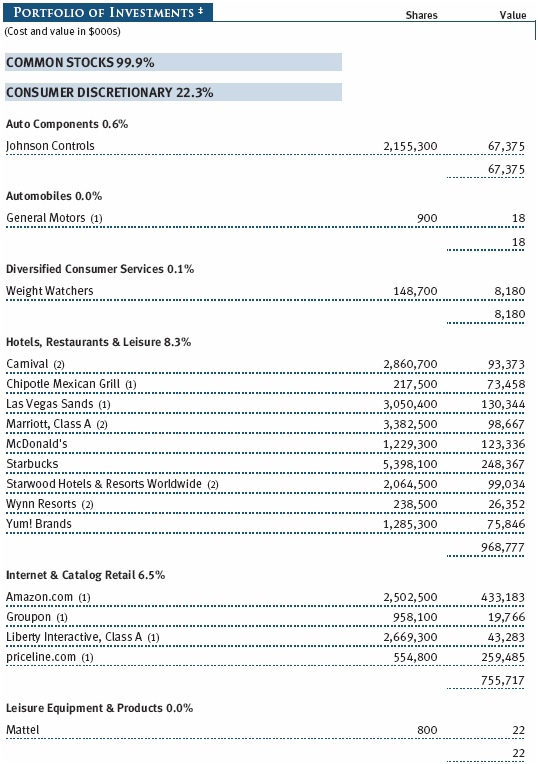
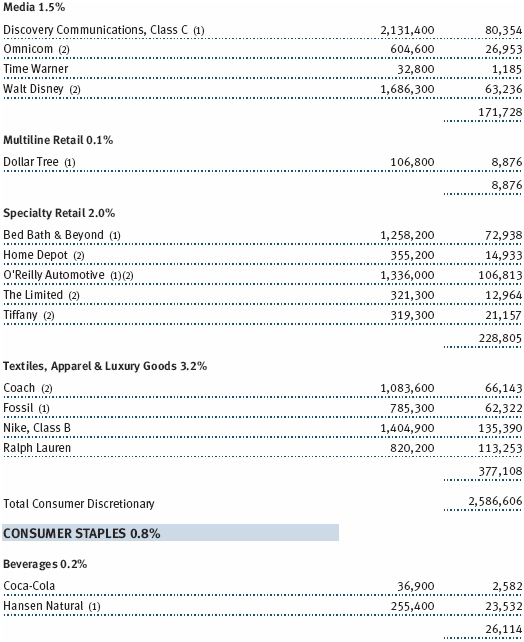
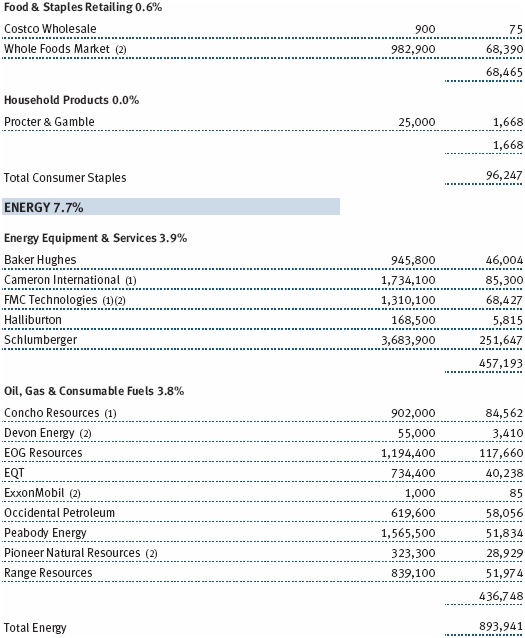
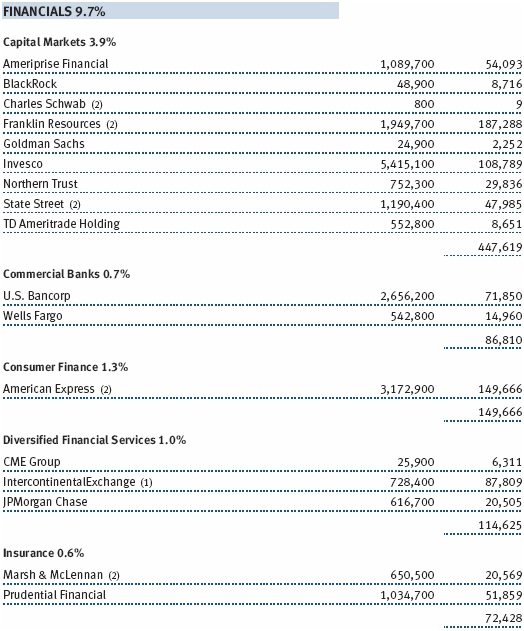
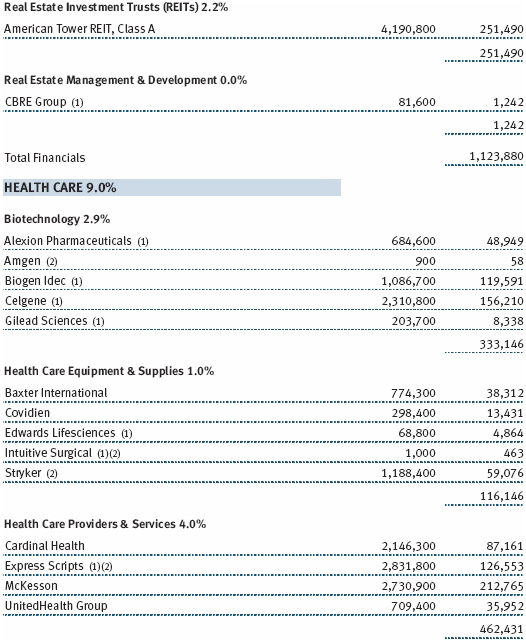
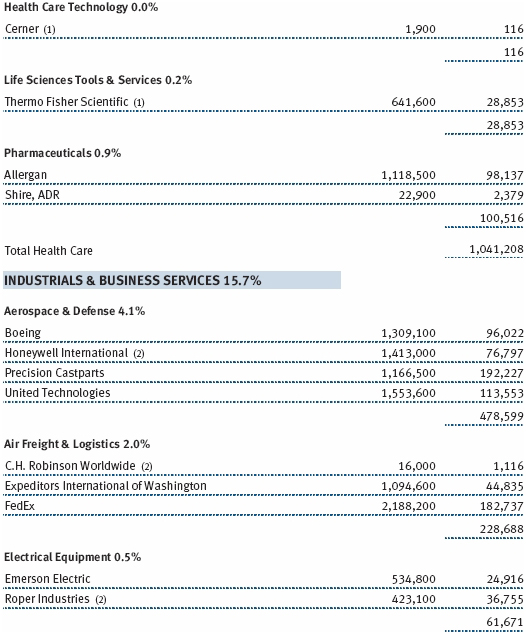
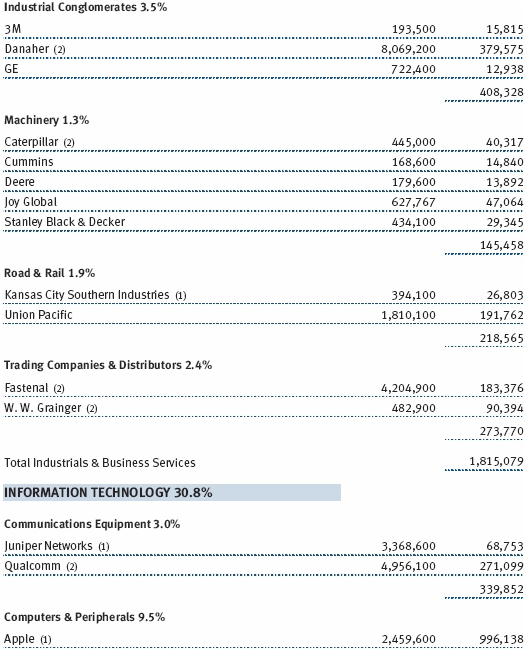
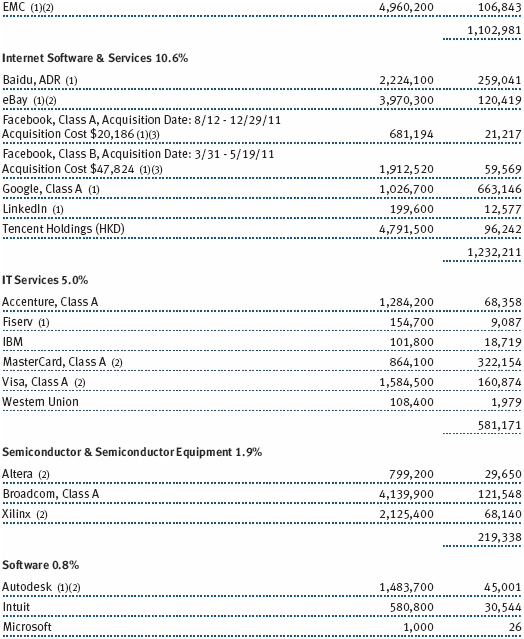
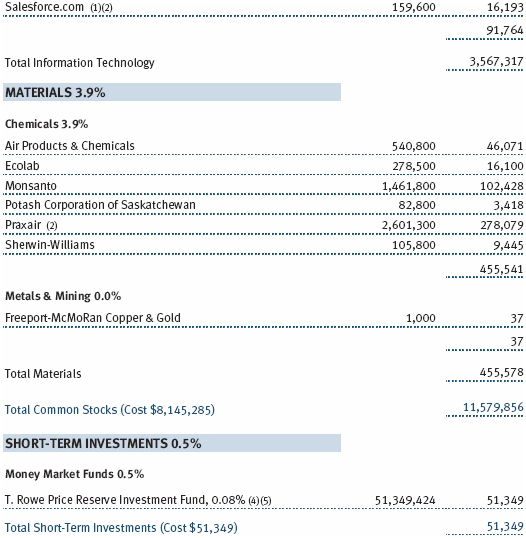
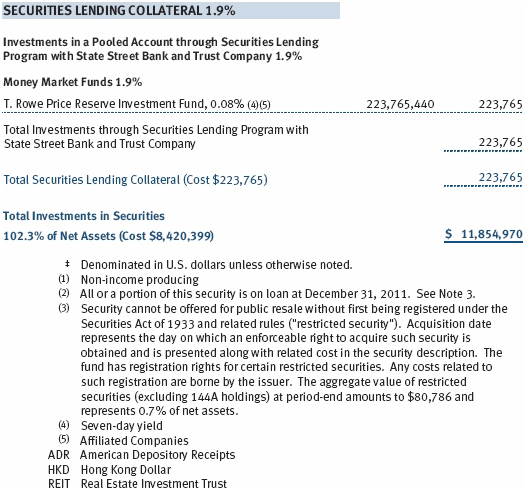
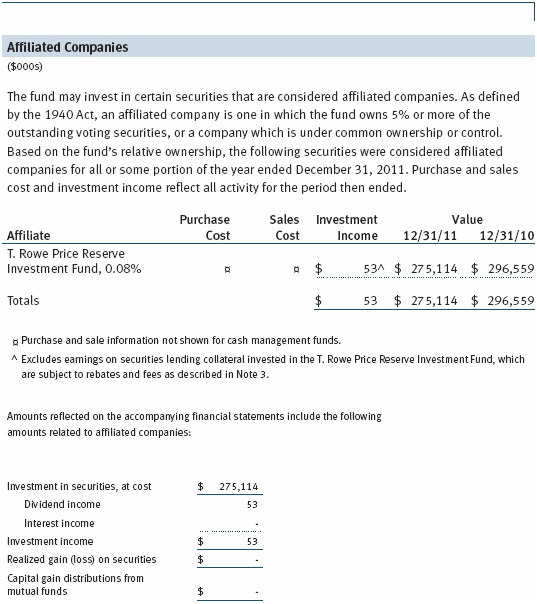
The accompanying notes are an integral part of these financial statements.
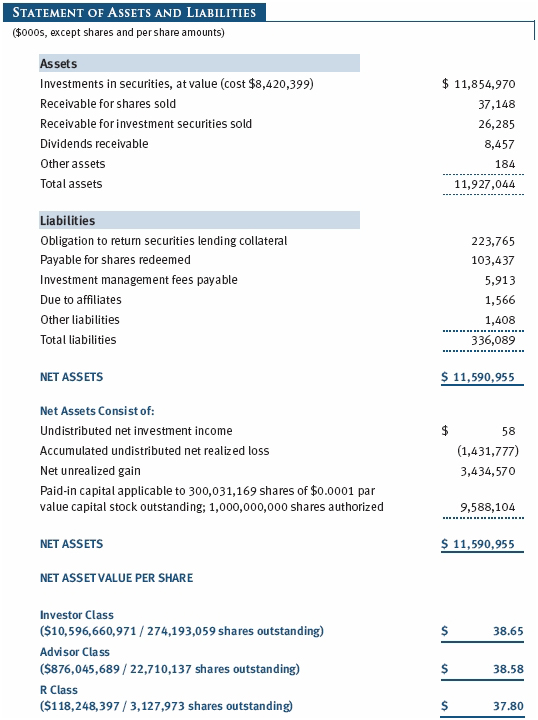
The accompanying notes are an integral part of these financial statements.
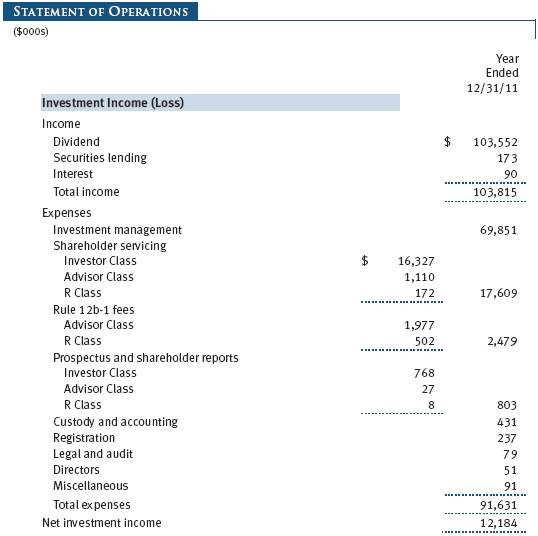
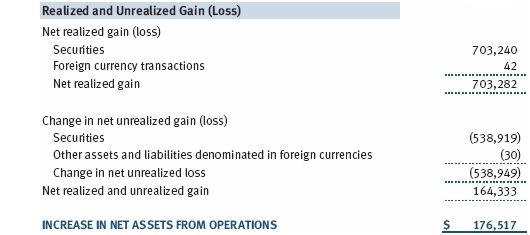
The accompanying notes are an integral part of these financial statements.
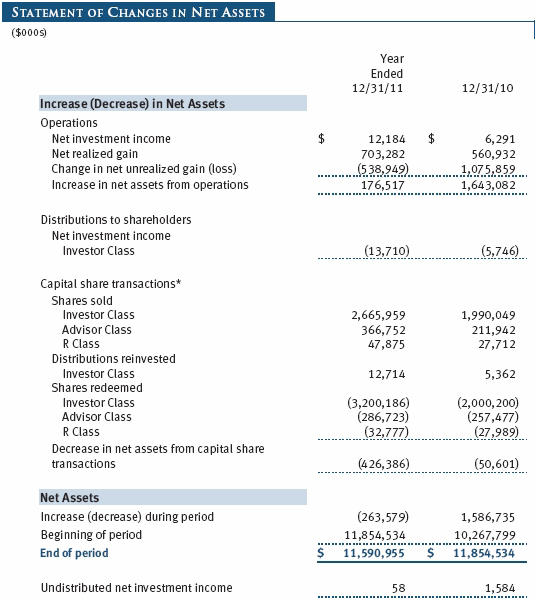
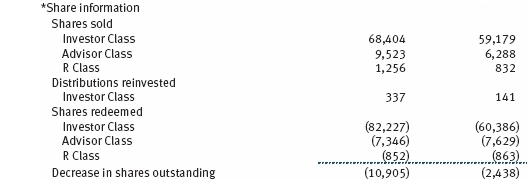
The accompanying notes are an integral part of these financial statements.
| Notes to Financial Statements |
T. Rowe Price Blue Chip Growth Fund, Inc. (the fund), is registered under the Investment Company Act of 1940 (the 1940 Act) as a diversified, open-end management investment company. The fund seeks to provide long-term capital growth. Income is a secondary objective. The fund has three classes of shares: the Blue Chip Growth Fund original share class, referred to in this report as the Investor Class, offered since June 30, 1993; the Blue Chip Growth Fund–Advisor Class (Advisor Class), offered since March 31, 2000; and the Blue Chip Growth Fund–R Class (R Class), offered since September 30, 2002. Advisor Class shares are sold only through unaffiliated brokers and other unaffiliated financial intermediaries, and R Class shares are available to retirement plans serviced by intermediaries. The Advisor Class and R Class each operate under separate Board-approved Rule 12b-1 plans, pursuant to which each class compensates financial intermediaries for distribution, shareholder servicing, and/or certain administrative services. Each class has exclusive voting rights on matters related solely to that class; separate voting rights on matters that relate to all classes; and, in all other respects, the same rights and obligations as the other classes.
NOTE 1 - SIGNIFICANT ACCOUNTING POLICIES
Basis of Preparation The accompanying financial statements were prepared in accordance with accounting principles generally accepted in the United States of America (GAAP), which require the use of estimates made by management. Management believes that estimates and valuations are appropriate; however, actual results may differ from those estimates, and the valuations reflected in the accompanying financial statements may differ from the value ultimately realized upon sale or maturity.
Investment Transactions, Investment Income, and Distributions Income and expenses are recorded on the accrual basis. Dividends received from mutual fund investments are reflected as dividend income; capital gain distributions are reflected as realized gain/loss. Dividend income and capital gain distributions are recorded on the ex-dividend date. Income tax-related interest and penalties, if incurred, would be recorded as income tax expense. Investment transactions are accounted for on the trade date. Realized gains and losses are reported on the identified cost basis. Distributions to shareholders are recorded on the ex-dividend date. Income distributions are declared and paid by each class annually. Capital gain distributions, if any, are generally declared and paid by the fund annually.
Currency Translation Assets, including investments, and liabilities denominated in foreign currencies are translated into U.S. dollar values each day at the prevailing exchange rate, using the mean of the bid and asked prices of such currencies against U.S. dollars as quoted by a major bank. Purchases and sales of securities, income, and expenses are translated into U.S. dollars at the prevailing exchange rate on the date of the transaction. The effect of changes in foreign currency exchange rates on realized and unrealized security gains and losses is reflected as a component of security gains and losses.
Class Accounting The Advisor Class and R Class each pay distribution, shareholder servicing, and/or certain administrative expenses in the form of Rule 12b-1 fees, in an amount not exceeding 0.25% and 0.50%, respectively, of the class’s average daily net assets. Shareholder servicing, prospectus, and shareholder report expenses incurred by each class are charged directly to the class to which they relate. Expenses common to all classes, investment income, and realized and unrealized gains and losses are allocated to the classes based upon the relative daily net assets of each class.
Rebates and Credits Subject to best execution, the fund may direct certain security trades to brokers who have agreed to rebate a portion of the related brokerage commission to the fund in cash. Commission rebates are reflected as realized gain on securities in the accompanying financial statements and totaled $237,000 for the year ended December 31, 2011. Additionally, the fund earns credits on temporarily uninvested cash balances held at the custodian, which reduce the fund’s custody charges. Custody expense in the accompanying financial statements is presented before reduction for credits.
In-Kind Redemptions In accordance with guidelines described in the fund’s prospectus, the fund may distribute portfolio securities rather than cash as payment for a redemption of fund shares (in-kind redemption). For financial reporting purposes, the fund recognizes a gain on in-kind redemptions to the extent the value of the distributed securities on the date of redemption exceeds the cost of those securities. Gains and losses realized on in-kind redemptions are not recognized for tax purposes and are reclassified from undistributed realized gain (loss) to paid-in capital. During the year ended December 31, 2011, the fund realized $415,425,000 of net gain on $852,262,000 of in-kind redemptions.
New Accounting Pronouncements In December 2011, the Financial Accounting Standards Board issued amended guidance to enhance disclosure for offsetting assets and liabilities. The guidance is effective for fiscal years and interim periods beginning on or after January 1, 2013; adoption will have no effect on the fund’s net assets or results of operations.
NOTE 2 - VALUATION
The fund’s financial instruments are reported at fair value as defined by GAAP. The fund determines the values of its assets and liabilities and computes each class’s net asset value per share at the close of the New York Stock Exchange (NYSE), normally 4 p.m. ET, each day that the NYSE is open for business. Values in the accompanying Portfolio of Investments are as of December 30, 2011, the last business day in the fund’s fiscal year ended December 31, 2011. Some foreign markets were open between December 30 and the close of the fund’s reporting period on December 31, but any differences in values and foreign exchange rates subsequent to December 30 through December 31 were immaterial to the fund’s financial statements.
Valuation Methods Equity securities listed or regularly traded on a securities exchange or in the over-the-counter (OTC) market are valued at the last quoted sale price or, for certain markets, the official closing price at the time the valuations are made, except for OTC Bulletin Board securities, which are valued at the mean of the latest bid and asked prices. A security that is listed or traded on more than one exchange is valued at the quotation on the exchange determined to be the primary market for such security. Listed securities not traded on a particular day are valued at the mean of the latest bid and asked prices for domestic securities and the last quoted sale price for international securities.
Investments in mutual funds are valued at the mutual fund’s closing net asset value per share on the day of valuation.
Other investments, including restricted securities and private placements, and those financial instruments for which the above valuation procedures are inappropriate or are deemed not to reflect fair value, are stated at fair value as determined in good faith by the T. Rowe Price Valuation Committee, established by the fund’s Board of Directors (the Board). Subject to oversight by the Board, the Valuation Committee develops pricing-related policies and procedures and approves all fair-value determinations. The Valuation Committee regularly makes good faith judgments, using a wide variety of sources and information, to establish and adjust valuations of certain securities as events occur and circumstances warrant. For instance, in determining the fair value of private-equity instruments, the Valuation Committee considers a variety of factors, including the company’s business prospects, its financial performance, strategic events impacting the company, relevant valuations of similar companies, new rounds of financing, and any negotiated transactions of significant size between other investors in the company. Because any fair-value determination involves a significant amount of judgment, there is a degree of subjectivity inherent in such pricing decisions.
For valuation purposes, the last quoted prices of non-U.S. equity securities may be adjusted under the circumstances described below. If the fund determines that developments between the close of a foreign market and the close of the NYSE will, in its judgment, materially affect the value of some or all of its portfolio securities, the fund will adjust the previous closing prices to reflect what it believes to be the fair value of the securities as of the close of the NYSE. In deciding whether it is necessary to adjust closing prices to reflect fair value, the fund reviews a variety of factors, including developments in foreign markets, the performance of U.S. securities markets, and the performance of instruments trading in U.S. markets that represent foreign securities and baskets of foreign securities. A fund may also fair value securities in other situations, such as when a particular foreign market is closed but the fund is open. The fund uses outside pricing services to provide it with closing prices and information to evaluate and/or adjust those prices. The fund cannot predict how often it will use closing prices and how often it will determine it necessary to adjust those prices to reflect fair value. As a means of evaluating its security valuation process, the fund routinely compares closing prices, the next day’s opening prices in the same markets, and adjusted prices. Additionally, trading in the underlying securities of the fund may take place in various foreign markets on certain days when the fund is not open for business and does not calculate a net asset value. As a result, net asset values may be significantly affected on days when shareholders cannot make transactions.
Valuation Inputs Various inputs are used to determine the value of the fund’s financial instruments. These inputs are summarized in the three broad levels listed below:
Level 1 – quoted prices in active markets for identical financial instruments
Level 2 – observable inputs other than Level 1 quoted prices (including, but not limited to, quoted prices for similar financial instruments, interest rates, prepayment speeds, and credit risk)
Level 3 – unobservable inputs
Observable inputs are those based on market data obtained from sources independent of the fund, and unobservable inputs reflect the fund’s own assumptions based on the best information available. The input levels are not necessarily an indication of the risk or liquidity associated with financial instruments at that level. For example, non-U.S. equity securities actively traded in foreign markets generally are reflected in Level 2 despite the availability of closing prices because the fund evaluates and determines whether those closing prices reflect fair value at the close of the NYSE or require adjustment, as described above. The following table summarizes the fund’s financial instruments, based on the inputs used to determine their values on December 31, 2011:
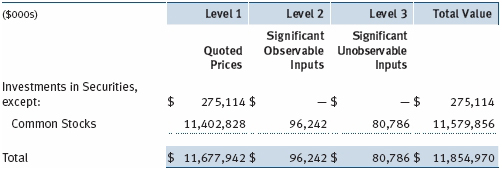
Following is a reconciliation of the fund’s Level 3 holdings for the year ended December 31, 2011. Gain (loss) reflects both realized and change in unrealized gain (loss) on Level 3 holdings during the period, if any, and is included on the accompanying Statement of Operations. The change in unrealized gain (loss) on Level 3 instruments held at December 31, 2011, totaled $12,776,000 for the year ended December 31, 2011.

NOTE 3 - OTHER INVESTMENT TRANSACTIONS
Consistent with its investment objective, the fund engages in the following practices to manage exposure to certain risks and/or to enhance performance. The investment objective, policies, program, and risk factors of the fund are described more fully in the fund’s prospectus and Statement of Additional Information.
Restricted Securities The fund may invest in securities that are subject to legal or contractual restrictions on resale. Prompt sale of such securities at an acceptable price may be difficult and may involve substantial delays and additional costs.
Securities Lending The fund lends its securities to approved brokers to earn additional income. It receives as collateral cash and U.S. government securities valued at 102% to 105% of the value of the securities on loan. Cash collateral is invested by the fund’s lending agent(s) in accordance with investment guidelines approved by management. Although risk is mitigated by the collateral, the fund could experience a delay in recovering its securities and a possible loss of income or value if the borrower fails to return the securities or if collateral investments decline in value. Securities lending revenue recognized by the fund consists of earnings on invested collateral and borrowing fees, net of any rebates to the borrower and compensation to the lending agent. In accordance with GAAP, investments made with cash collateral are reflected in the accompanying financial statements, but collateral received in the form of securities are not. On December 31, 2011, the value of cash collateral investments was $223,765,000, and the value of loaned securities was $218,043,000.
Other Purchases and sales of portfolio securities other than short-term securities aggregated $5,166,181,000 and $5,542,501,000, respectively, for the year ended December 31, 2011.
NOTE 4 - FEDERAL INCOME TAXES
No provision for federal income taxes is required since the fund intends to continue to qualify as a regulated investment company under Subchapter M of the Internal Revenue Code and distribute to shareholders all of its taxable income and gains. Distributions determined in accordance with federal income tax regulations may differ in amount or character from net investment income and realized gains for financial reporting purposes. Financial reporting records are adjusted for permanent book/tax differences to reflect tax character but are not adjusted for temporary differences.
The fund files U.S. federal, state, and local tax returns as required. The fund’s tax returns are subject to examination by the relevant tax authorities until expiration of the applicable statute of limitations, which is generally three years after the filing of the tax return but which can be extended to six years in certain circumstances. Tax returns for open years have incorporated no uncertain tax positions that require a provision for income taxes.
Reclassifications to paid-in capital relate primarily to redemptions in kind. For the year ended December 31, 2011, the following reclassifications were recorded to reflect tax character (there was no impact on results of operations or net assets):

Distributions during the years ended December 31, 2011 and December 31, 2010, totaled $13,710,000 and $5,746,000, respectively, and were characterized as ordinary income for tax purposes. At December 31, 2011, the tax-basis cost of investments and components of net assets were as follows:
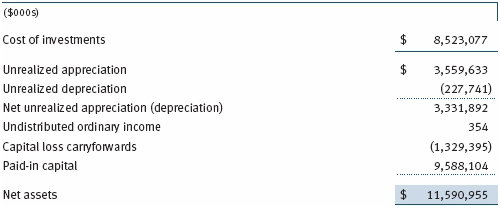
The difference between book-basis and tax-basis net unrealized appreciation (depreciation) is attributable to the deferral of losses from wash sales for tax purposes. As a result of the Regulated Investment Company Modernization Act of 2010, net capital losses realized on or after January 1, 2011 (effective date) may be carried forward indefinitely to offset future realized capital gains; however, post-effective losses must be used before pre-effective capital loss carryforwards with expiration dates. Accordingly, it is possible that all or a portion of the fund’s pre-effective capital loss carryforwards could expire unused. All or a portion of the fund’s capital loss carryforwards may be from losses realized between November 1 and the fund’s fiscal year-end, which are deferred for tax purposes until the subsequent year but recognized for financial reporting purposes in the year realized. The fund intends to retain realized gains to the extent of available capital loss carryforwards. During the year ended December 31, 2011, the fund utilized $346,131,000 of capital loss carryforwards. The fund’s available capital loss carryforwards as of December 31, 2011, expire as follows: $35,130,000 in fiscal 2016 and $1,244,418,000 in fiscal 2017; $49,847,000 have no expiration.
NOTE 5 - RELATED PARTY TRANSACTIONS
The fund is managed by T. Rowe Price Associates, Inc. (Price Associates), a wholly owned subsidiary of T. Rowe Price Group, Inc. (Price Group). The investment management agreement between the fund and Price Associates provides for an annual investment management fee, which is computed daily and paid monthly. The individual fund fee is equal to 0.30% of the fund’s average daily net assets up to $15 billion and 0.255% of the fund’s average daily net assets in excess of $15 billion. The group fee rate is calculated based on the combined net assets of certain mutual funds sponsored by Price Associates (the group) applied to a graduated fee schedule, with rates ranging from 0.48% for the first $1 billion of assets to 0.28% for assets in excess of $300 billion. The fund’s group fee is determined by applying the group fee rate to the fund’s average daily net assets. At December 31, 2011, the effective annual group fee rate was 0.30%.
In addition, the fund has entered into service agreements with Price Associates and two wholly owned subsidiaries of Price Associates (collectively, Price). Price Associates computes the daily share prices and provides certain other administrative services to the fund. T. Rowe Price Services, Inc., provides shareholder and administrative services in its capacity as the fund’s transfer and dividend disbursing agent. T. Rowe Price Retirement Plan Services, Inc., provides subaccounting and recordkeeping services for certain retirement accounts invested in the Investor Class and R Class. For the year ended December 31, 2011, expenses incurred pursuant to these service agreements were $124,000 for Price Associates; $3,265,000 for T. Rowe Price Services, Inc.; and $4,351,000 for T. Rowe Price Retirement Plan Services, Inc. The total amount payable at period-end pursuant to these service agreements is reflected as Due to Affiliates in the accompanying financial statements.
Additionally, the fund is one of several mutual funds in which certain college savings plans managed by Price Associates may invest. As approved by the fund’s Board of Directors, shareholder servicing costs associated with each college savings plan are borne by the fund in proportion to the average daily value of its shares owned by the college savings plan. For the year ended December 31, 2011, the fund was charged $1,003,000 for shareholder servicing costs related to the college savings plans, of which $767,000 was for services provided by Price. The amount payable at period-end pursuant to this agreement is reflected as Due to Affiliates in the accompanying financial statements. At December 31, 2011, approximately 5% of the outstanding shares of the Investor Class were held by college savings plans.
The fund is also one of several mutual funds sponsored by Price Associates (underlying Price funds) in which the T. Rowe Price Spectrum Funds (Spectrum Funds) may invest. The Spectrum Funds do not invest in the underlying Price funds for the purpose of exercising management or control. Pursuant to a special servicing agreement, expenses associated with the operation of the Spectrum Funds are borne by each underlying Price fund to the extent of estimated savings to it and in proportion to the average daily value of its shares owned by the Spectrum Funds. Expenses allocated under this agreement are reflected as shareholder servicing expense in the accompanying financial statements. For the year ended December 31, 2011, the fund was allocated $733,000 of Spectrum Funds’ expenses, of which $480,000 related to services provided by Price. The amount payable at period-end pursuant to this agreement is reflected as Due to Affiliates in the accompanying financial statements. At December 31, 2011, approximately 4% of the outstanding shares of the Investor Class were held by the Spectrum Funds.
The fund may invest in the T. Rowe Price Reserve Investment Fund and the T. Rowe Price Government Reserve Investment Fund (collectively, the T. Rowe Price Reserve Investment Funds), open-end management investment companies managed by Price Associates and considered affiliates of the fund. The T. Rowe Price Reserve Investment Funds are offered as cash management options to mutual funds, trusts, and other accounts managed by Price Associates and/or its affiliates and are not available for direct purchase by members of the public. The T. Rowe Price Reserve Investment Funds pay no investment management fees.
| Report of Independent Registered Public Accounting Firm |
To the Board of Directors and Shareholders of
T. Rowe Price Blue Chip Growth Fund, Inc.
In our opinion, the accompanying statement of assets and liabilities, including the portfolio of investments, and the related statements of operations and of changes in net assets and the financial highlights present fairly, in all material respects, the financial position of T. Rowe Price Blue Chip Growth Fund, Inc. (the “Fund”) at December 31, 2011, and the results of its operations, the changes in its net assets and the financial highlights for each of the periods indicated therein, in conformity with accounting principles generally accepted in the United States of America. These financial statements and financial highlights (hereafter referred to as “financial statements”) are the responsibility of the Fund’s management; our responsibility is to express an opinion on these financial statements based on our audits. We conducted our audits of these financial statements in accordance with the standards of the Public Company Accounting Oversight Board (United States). Those standards require that we plan and perform the audit to obtain reasonable assurance about whether the financial statements are free of material misstatement. An audit includes examining, on a test basis, evidence supporting the amounts and disclosures in the financial statements, assessing the accounting principles used and significant estimates made by management, and evaluating the overall financial statement presentation. We believe that our audits, which included confirmation of securities at December 31, 2011 by correspondence with the custodian, and confirmation of the underlying funds by correspondence with the transfer agent, provide a reasonable basis for our opinion.
PricewaterhouseCoopers LLP
Baltimore, Maryland
February 17, 2012
| Tax Information (Unaudited) for the Tax Year Ended 12/31/11 |
We are providing this information as required by the Internal Revenue Code. The amounts shown may differ from those elsewhere in this report because of differences between tax and financial reporting requirements.
For taxable non-corporate shareholders, $12,226,000 of the fund’s income represents qualified dividend income subject to the 15% rate category.
For corporate shareholders, $12,226,000 of the fund’s income qualifies for the dividends-received deduction.
| Information on Proxy Voting Policies, Procedures, and Records |
A description of the policies and procedures used by T. Rowe Price funds and portfolios to determine how to vote proxies relating to portfolio securities is available in each fund’s Statement of Additional Information, which you may request by calling 1-800-225-5132 or by accessing the SEC’s website, sec.gov. The description of our proxy voting policies and procedures is also available on our website, troweprice.com. To access it, click on the words “Our Company” at the top of our corporate homepage. Then, when the next page appears, click on the words “Proxy Voting Policies” on the left side of the page.
Each fund’s most recent annual proxy voting record is available on our website and through the SEC’s website. To access it through our website, follow the directions above, then click on the words “Proxy Voting Records” on the right side of the Proxy Voting Policies page.
| How to Obtain Quarterly Portfolio Holdings |
The fund files a complete schedule of portfolio holdings with the Securities and Exchange Commission for the first and third quarters of each fiscal year on Form N-Q. The fund’s Form N-Q is available electronically on the SEC’s website (sec.gov); hard copies may be reviewed and copied at the SEC’s Public Reference Room, 450 Fifth St. N.W., Washington, DC 20549. For more information on the Public Reference Room, call 1-800-SEC-0330.
| About the Fund’s Directors and Officers |
Your fund is overseen by a Board of Directors (Board) that meets regularly to review a wide variety of matters affecting the fund, including performance, investment programs, compliance matters, advisory fees and expenses, service providers, and other business affairs. The Board elects the fund’s officers, who are listed in the final table. At least 75% of the Board’s members are independent of T. Rowe Price Associates, Inc. (T. Rowe Price), and its affiliates; “inside” or “interested” directors are employees or officers of T. Rowe Price. The business address of each director and officer is 100 East Pratt Street, Baltimore, Maryland 21202. The Statement of Additional Information includes additional information about the fund directors and is available without charge by calling a T. Rowe Price representative at 1-800-638-5660.
| Independent Directors | ||
| Name | ||
| (Year of Birth) | Principal Occupation(s) and Directorships of Public Companies and | |
| Year Elected* | Other Investment Companies During the Past Five Years | |
| William R. Brody, M.D., Ph.D. | President and Trustee, Salk Institute for Biological Studies (2009 | |
| (1944) | to present); Director, Novartis, Inc. (2009 to present); Director, IBM | |
| 2009 | (2007 to present); President and Trustee, Johns Hopkins University | |
| (1996 to 2009); Chairman of Executive Committee and Trustee, | ||
| Johns Hopkins Health System (1996 to 2009) | ||
| Jeremiah E. Casey | Retired | |
| (1940) | ||
| 2005 | ||
| Anthony W. Deering | Chairman, Exeter Capital, LLC, a private investment firm (2004 | |
| (1945) | to present); Director, Under Armour (2008 to present); Director, | |
| 2001 | Vornado Real Estate Investment Trust (2004 to present); Director, | |
| Mercantile Bankshares (2002 to 2007); Director and Member of the | ||
| Advisory Board, Deutsche Bank North America (2004 to present) | ||
| Donald W. Dick, Jr. | Principal, EuroCapital Partners, LLC, an acquisition and management | |
| (1943) | advisory firm (1995 to present) | |
| 1993 | ||
| Karen N. Horn | Senior Managing Director, Brock Capital Group, an advisory and | |
| (1943) | investment banking firm (2004 to present); Director, Eli Lilly and | |
| 2003 | Company (1987 to present); Director, Simon Property Group (2004 | |
| to present); Director, Norfolk Southern (2008 to present); Director, | ||
| Fannie Mae (2006 to 2008) | ||
| Theo C. Rodgers | President, A&R Development Corporation (1977 to present) | |
| (1941) | ||
| 2005 | ||
| John G. Schreiber | Owner/President, Centaur Capital Partners, Inc., a real estate | |
| (1946) | investment company (1991 to present); Cofounder and Partner, | |
| 2001 | Blackstone Real Estate Advisors, L.P. (1992 to present); Director, | |
| General Growth Properties, Inc. (2010 to present) | ||
| Mark R. Tercek | President and Chief Executive Officer, The Nature Conservancy | |
| (1957) | (2008 to present); Managing Director, The Goldman Sachs Group, | |
| 2009 | Inc. (1984 to 2008) | |
| *Each independent director oversees 130 T. Rowe Price portfolios and serves until retirement, resignation, or election of a successor. | ||
| Inside Directors | ||
| Name | ||
| (Year of Birth) | ||
| Year Elected* | ||
| [Number of T. Rowe Price | Principal Occupation(s) and Directorships of Public Companies and | |
| Portfolios Overseen] | Other Investment Companies During the Past Five Years | |
| Edward C. Bernard | Director and Vice President, T. Rowe Price; Vice Chairman of the | |
| (1956) | Board, Director, and Vice President, T. Rowe Price Group, Inc.; | |
| 2006 | Chairman of the Board, Director, and President, T. Rowe Price | |
| [130] | Investment Services, Inc.; Chairman of the Board and Director, | |
| T. Rowe Price Retirement Plan Services, Inc., T. Rowe Price Savings | ||
| Bank, and T. Rowe Price Services, Inc.; Chairman of the Board, Chief | ||
| Executive Officer, and Director, T. Rowe Price International; Chief | ||
| Executive Officer, Chairman of the Board, Director, and President, | ||
| T. Rowe Price Trust Company; Chairman of the Board, all funds | ||
| Brian C. Rogers, CFA, CIC | Chief Investment Officer, Director, and Vice President, T. Rowe Price; | |
| (1955) | Chairman of the Board, Chief Investment Officer, Director, and Vice | |
| 2006 | President, T. Rowe Price Group, Inc.; Vice President, T. Rowe Price | |
| [74] | Trust Company | |
| *Each inside director serves until retirement, resignation, or election of a successor. | ||
| Officers | ||
| Name (Year of Birth) | ||
| Position Held With Blue Chip Growth Fund | Principal Occupation(s) | |
| P. Robert Bartolo, CFA, CPA (1972) | Vice President, T. Rowe Price, T. Rowe Price | |
| Vice President | Group, Inc., and T. Rowe Price Trust Company | |
| Peter J. Bates, CFA (1974) | Vice President, T. Rowe Price and T. Rowe Price | |
| Vice President | Group, Inc. | |
| Ryan Burgess CFA (1974) | Vice President, T. Rowe Price and T. Rowe Price | |
| Vice President | Group, Inc. | |
| G. Mark Bussard (1972) | Vice President, T. Rowe Price and T. Rowe Price | |
| Vice President | Group, Inc. | |
| Jonathan Chou (1980) | Vice President, T. Rowe Price and T. Rowe Price | |
| Vice President | Group, Inc.; formerly student, Darden Graduate | |
| School of Business Administration, University | ||
| of Virginia (to 2008) | ||
| Shawn T. Driscoll (1975) | Vice President, T. Rowe Price Group, Inc.; | |
| Vice President | formerly Equity Research Analyst, MTB | |
| Investment Advisors (to 2006) | ||
| David J. Eiswert, CFA (1972) | Vice President, T. Rowe Price, T. Rowe Price | |
| Vice President | Group, Inc., and T. Rowe Price International | |
| Roger L. Fiery III, CPA (1959) | Vice President, Price Hong Kong, Price | |
| Vice President | Singapore, T. Rowe Price, T. Rowe Price Group, | |
| Inc., T. Rowe Price International, and T. Rowe | ||
| Price Trust Company | ||
| John R. Gilner (1961) | Chief Compliance Officer and Vice President, | |
| Chief Compliance Officer | T. Rowe Price; Vice President, T. Rowe Price | |
| Group, Inc., and T. Rowe Price Investment | ||
| Services, Inc. | ||
| Gregory S. Golczewski (1966) | Vice President, T. Rowe Price and T. Rowe Price | |
| Vice President | Trust Company | |
| Paul D. Greene II (1978) | Vice President, T. Rowe Price and T. Rowe Price | |
| Vice President | Group, Inc. | |
| Gregory K. Hinkle, CPA (1958) | Vice President, T. Rowe Price, T. Rowe Price | |
| Treasurer | Group, Inc., and T. Rowe Price Trust Company; | |
| formerly Partner, PricewaterhouseCoopers LLP | ||
| (to 2007) | ||
| Thomas J. Huber, CFA (1966) | Vice President, T. Rowe Price, T. Rowe Price | |
| Vice President | Group, Inc., and T. Rowe Price Trust Company | |
| Michael M. Lasota (1982) | Vice President, T. Rowe Price and T. Rowe Price | |
| Vice President | Group, Inc.; formerly student, University of | |
| Chicago, Graduate School of Business (to 2008) | ||
| Patricia B. Lippert (1953) | Assistant Vice President, T. Rowe Price and | |
| Secretary | T. Rowe Price Investment Services, Inc. | |
| George Marzano (1980) | Vice President, T. Rowe Price | |
| Vice President | ||
| David Oestreicher (1967) | Director and Vice President, T. Rowe Price | |
| Vice President | Investment Services, Inc., T. Rowe Price | |
| Retirement Plan Services, Inc., T. Rowe | ||
| Price Services, Inc., and T. Rowe Price Trust | ||
| Company; Vice President, Price Hong Kong, | ||
| Price Singapore, T. Rowe Price, T. Rowe Price | ||
| Group, Inc., and T. Rowe Price International | ||
| Timothy E. Parker, CFA (1974) | Vice President, T. Rowe Price and T. Rowe Price | |
| Vice President | Group, Inc. | |
| Larry J. Puglia, CFA, CPA (1960) | Vice President, T. Rowe Price, T. Rowe Price | |
| President | Group, Inc., and T. Rowe Price Trust Company | |
| Deborah D. Seidel (1962) | Vice President, T. Rowe Price, T. Rowe Price | |
| Vice President | Group, Inc., and T. Rowe Price Investment | |
| Services, Inc.; Assistant Treasurer and Vice | ||
| President, T. Rowe Price Services, Inc. | ||
| Robert W. Sharps, CFA, CPA (1971) | Vice President, T. Rowe Price, T. Rowe Price | |
| Vice President | Group, Inc., and T. Rowe Price Trust Company | |
| Taymour R. Tamaddon, CFA (1976) | Vice President, T. Rowe Price and T. Rowe Price | |
| Vice President | Group, Inc. | |
| Julie L. Waples (1970) | Vice President, T. Rowe Price | |
| Vice President | ||
| Unless otherwise noted, officers have been employees of T. Rowe Price or T. Rowe Price International for at least 5 years. | ||
Item 2. Code of Ethics.
The registrant has adopted a code of ethics, as defined in Item 2 of Form N-CSR, applicable to its principal executive officer, principal financial officer, principal accounting officer or controller, or persons performing similar functions. A copy of this code of ethics is filed as an exhibit to this Form N-CSR. No substantive amendments were approved or waivers were granted to this code of ethics during the period covered by this report.
Item 3. Audit Committee Financial Expert.
The registrant’s Board of Directors/Trustees has determined that Mr. Anthony W. Deering qualifies as an audit committee financial expert, as defined in Item 3 of Form N-CSR. Mr. Deering is considered independent for purposes of Item 3 of Form N-CSR.
Item 4. Principal Accountant Fees and Services.
(a) – (d) Aggregate fees billed to the registrant for the last two fiscal years for professional services rendered by the registrant’s principal accountant were as follows:

Audit fees include amounts related to the audit of the registrant’s annual financial statements and services normally provided by the accountant in connection with statutory and regulatory filings. Audit-related fees include amounts reasonably related to the performance of the audit of the registrant’s financial statements and specifically include the issuance of a report on internal controls and, if applicable, agreed-upon procedures related to fund acquisitions. Tax fees include amounts related to services for tax compliance, tax planning, and tax advice. The nature of these services specifically includes the review of distribution calculations and the preparation of Federal, state, and excise tax returns. All other fees include the registrant’s pro-rata share of amounts for agreed-upon procedures in conjunction with service contract approvals by the registrant’s Board of Directors/Trustees.
(e)(1) The registrant’s audit committee has adopted a policy whereby audit and non-audit services performed by the registrant’s principal accountant for the registrant, its investment adviser, and any entity controlling, controlled by, or under common control with the investment adviser that provides ongoing services to the registrant require pre-approval in advance at regularly scheduled audit committee meetings. If such a service is required between regularly scheduled audit committee meetings, pre-approval may be authorized by one audit committee member with ratification at the next scheduled audit committee meeting. Waiver of pre-approval for audit or non-audit services requiring fees of a de minimis amount is not permitted.
(2) No services included in (b) – (d) above were approved pursuant to paragraph (c)(7)(i)(C) of Rule 2-01 of Regulation S-X.
(f) Less than 50 percent of the hours expended on the principal accountant’s engagement to audit the registrant’s financial statements for the most recent fiscal year were attributed to work performed by persons other than the principal accountant’s full-time, permanent employees.
(g) The aggregate fees billed for the most recent fiscal year and the preceding fiscal year by the registrant’s principal accountant for non-audit services rendered to the registrant, its investment adviser, and any entity controlling, controlled by, or under common control with the investment adviser that provides ongoing services to the registrant were $1,764,000 and $1,417,000, respectively.
(h) All non-audit services rendered in (g) above were pre-approved by the registrant’s audit committee. Accordingly, these services were considered by the registrant’s audit committee in maintaining the principal accountant’s independence.
Item 5. Audit Committee of Listed Registrants.
Not applicable.
Item 6. Investments.
(a) Not applicable. The complete schedule of investments is included in Item 1 of this Form N-CSR.
(b) Not applicable.
Item 7. Disclosure of Proxy Voting Policies and Procedures for Closed-End Management Investment Companies.
Not applicable.
Item 8. Portfolio Managers of Closed-End Management Investment Companies.
Not applicable.
Item 9. Purchases of Equity Securities by Closed-End Management Investment Company and Affiliated Purchasers.
Not applicable.
Item 10. Submission of Matters to a Vote of Security Holders.
Not applicable.
Item 11. Controls and Procedures.
(a) The registrant’s principal executive officer and principal financial officer have evaluated the registrant’s disclosure controls and procedures within 90 days of this filing and have concluded that the registrant’s disclosure controls and procedures were effective, as of that date, in ensuring that information required to be disclosed by the registrant in this Form N-CSR was recorded, processed, summarized, and reported timely.
(b) The registrant’s principal executive officer and principal financial officer are aware of no change in the registrant’s internal control over financial reporting that occurred during the registrant’s second fiscal quarter covered by this report that has materially affected, or is reasonably likely to materially affect, the registrant’s internal control over financial reporting.
Item 12. Exhibits.
(a)(1) The registrant’s code of ethics pursuant to Item 2 of Form N-CSR is attached.
(3) Written solicitation to repurchase securities issued by closed-end companies: not applicable.
(b) A certification by the registrant's principal executive officer and principal financial officer, pursuant to Section 906 of the Sarbanes-Oxley Act of 2002 and required by Rule 30a-2(b) under the Investment Company Act of 1940, is attached.
SIGNATURES
Pursuant to the requirements of the Securities Exchange Act of 1934 and the Investment Company Act of 1940, the registrant has duly caused this report to be signed on its behalf by the undersigned, thereunto duly authorized.
T. Rowe Price Blue Chip Growth Fund, Inc.
| By | /s/ Edward C. Bernard | |
| Edward C. Bernard | ||
| Principal Executive Officer | ||
| Date February 17, 2012 | ||
Pursuant to the requirements of the Securities Exchange Act of 1934 and the Investment Company Act of 1940, this report has been signed below by the following persons on behalf of the registrant and in the capacities and on the dates indicated.
| By | /s/ Edward C. Bernard | |
| Edward C. Bernard | ||
| Principal Executive Officer | ||
| Date February 17, 2012 | ||
| By | /s/ Gregory K. Hinkle | |
| Gregory K. Hinkle | ||
| Principal Financial Officer | ||
| Date February 17, 2012 | ||